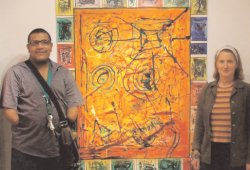In attempting to make their mark professionally, refugee artists face a number of barriers. Paul Glinkowski speaks to those involved in an innovative peer-to-peer mentoring project set up by Croydon Council.
The project came about in quite an organic way, says Sarah Wickens, Cultural Projects Officer at the London Borough of Croydon. I met Ze Tubia through the Croydon Refugee Project and it made me consider the additional difficulties that a refugee artist who also has disabilities must face. It was clear that there was a need for a fellow artist to support him in a way that no one else in the Borough arts team could. At that time, early in 2005, Ze Tubia had been in England for six months. He had to leave his native Angola the previous year after participating in an exhibition that highlighted the lack of government action to deal with problems caused by landmines. Ze Tubia had himself been the victim of a landmine at the age of seven.

Peer-to-peer mentoring seemed the best solution because working with a fellow artist could address the essential needs that artists have in common: finding where to access materials, for example, or learning about the exhibitions circuit in London. Ze Tubias English was basic, so it was decided that the mentoring should happen over an extended period. Thirty half-day sessions were arranged over 18 months. Jane Bailey was chosen as mentor because she had previously worked with refugee artists and community groups as lead artist on Opening Doors, a project run by Southwark-based Art in the Park. It is definitely worth investing the time at the outset to find the right mentor, says Wickens, particularly if it is another artist. They must have the generosity to take time away from their own practice to work sympathetically with another artist over a long period.
When I first arrived in England I really found it hard, says Ze Tubia. The way artists work here is very different from Angola. I wanted to meet other artists, but I didnt know where to start or who to go to. I didnt understand how the arts in London worked. The specialist language used by artists was a particular challenge. I had an interpreter who could understand the words but not the meanings, says Ze Tubia. It took another artist to understand. Bailey though, feels that it wasnt just the art side that was important. It was a lot less about giving information and a lot more about establishing a relationship of trust of being responsive to Ze Tubias general life situation, as well as to his art situation.
The mentoring period culminated with an exhibition of Ze Tubias new paintings, Cycle of the Repeated VII Millennium, took place at the Space C Gallery at Croydon Clocktower in October. Encouraged by the rapport that had grown up between the artists, Croydon Clocktower commissioned them to work together to produce a new work for the show. Bailey used her expertise as a filmmaker to help shape Ze Tubias desire to return again to the theme of landmines, resulting in a seven minute video piece, Land. Wickens feels the project has been a success. An evaluation is taking place to help identify where Ze Tubia will go next. Ze Tubias English has improved a lot, says Wickens, and he may now be better equipped to apply for things on his own. Were planning to establish an informal supportive link-up between locally based artists and I hope Ze Tubia will have a role in that.
Two years after arriving in England, Ze Tubia is pleased with his progress. I have come from a country where I was a well known artist and it has been a difficult transition, he says, but I feel born again; I feel a new Ze Tubia. If I hadnt worked with Jane, it would have taken much longer to reach where I am now.
Paul Glinkowski is Rootstein Hopkins Research Fellow at Wimbledon College of Art, University of the Arts London.
e: paulglink@btinternet.com



